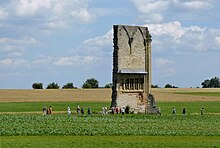Anhausen Abbey (Satteldorf)
The monastery Anhausen was a Paulines - hermit monastery in today's borough of Saddle village in the district of Schwäbisch Hall in Baden-Wuerttemberg . Today there is only a 18 m high and 10 m long free-standing wall of the former monastery, the Anhäuser Wall . It stands about 150 meters east of the county road between Bölgental and Wallhausen, northwest of Gröningen.
Previous buildings
A Marienkapelle in Anhausen was first mentioned in 1344. In 1357 Lupold von Bebenburg had it rebuilt on a larger scale. The hermit brother Konrad had lived by the chapel since 1359, and in the following year he was separated from the parish church in Gröningen (today part of Satteldorf). In 1390 three altars were consecrated by the Würzburg auxiliary bishop under the hermit brother Markward .
History of the monastery
In 1403 a monastery was donated in place of the hermitage by Hermann von Hornburg, his mother Barbara von Merkingen and Konrad von Bebenburg, which was given to the Pauline hermits. The founding of the monastery was confirmed in 1404 by the Bishop of Würzburg and in 1418 by Pope Martin V in Constance . The Hornburgers acted as patrons of the monastery and ensured its viability through numerous donations . After the Hornburgs died out, they were replaced by the Bebenburgers .
In 1436 the parish Wallhausen was incorporated by the Bishop of Würzburg to increase the income . In 1445 the monastery burned down, but was immediately rebuilt by Georg von Bebenburg. In 1469 Georg von Bebenburg gave the parish of Oberasbach to the monastery . In 1480 Wilhelm von Crailsheim donated the so-called Crailsheim Chapel, and there was also a St. Anne's Chapel in the south of the complex.
End of the monastery
In 1504 the Margraves of Ansbach became patrons of the monastery. After the Ansbach had introduced the Reformation , Margrave Georg forbade the admission of novices in Anhausen in 1528 in order to let the monastery die out. After the death of the last prior Leonhard Loess, the monastery was finally closed in 1557 and converted into a leasehold . From 1700 the plant was canceled. Today only the north wall of the Crailsheim Chapel can be found above ground with the Anhäuser Wall. The growth pattern that emerged from aerial photographs suggests that the convent house , the prior's house and farm buildings were located south of the preserved part of the wall , the foundations of which could possibly still be excavated.
Epitaphs
In the wall, which is still standing today, five epitaphs for the Lords of Bebenburg are set, which have a very different degree of preservation . The epitaphs are souvenir pictures that were probably attached by Wilhelm von Bebenburg (1496 to 1502 bailiff of Lobenhausen ), and not grave slabs . At least Lupold von Bebenburg is certain that he was not buried here, but in Bamberg Cathedral . Their coats of arms are shown in each corner .
The people are, from right to left:
- Lupold von Bebenburg , died on October 28, 1363 in Bamberg.
- Engelhardt von Bebenburg, died 1410
- Wilhelm the Elder of Bebenburg, died 1412
- Wilhelm the Younger von Bebenburg, died 1416
- Georg (Jörg) von Bebenburg, died in 1472. The figure broke out in 1925 due to the weather. This event was the reason to install the protective roof that still exists today.
A picture of the Virgin Mary among the line of Bebenburgers has meanwhile been completely destroyed.
literature
- Georg Paul Hönn : Anhausen . In: Lexicon Topographicum of the Franconian Craises . Johann Georg Lochner, Frankfurt and Leipzig 1747, p. 313 ( digitized version ).
- Gottfried Stieber: Anhaussen . In: Historical and topographical news from the Principality of Brandenburg-Onolzbach . Johann Jacob Enderes, Schwabach 1761, p. 200–201 ( digitized version ).
Web links
- Location of the Anhausen monastery on: State Agency for the Environment Baden-Württemberg (LUBW) ( information )
- Location of the Anhausen monastery on: Geoportal Baden-Württemberg ( information )
- Information page Anhäuser Mauer
- Anhausen Monastery (Satteldorf) in the database of Monasteries in Baden-Württemberg of the Baden-Württemberg State Archives
- Anhausen in the Peasants' War
- The Bebenburg house
Individual evidence
- ↑ http://www.archaeologie-bw.de/braasch/anhausen.html
- ^ Otto Ströbel: Wallhausen . Hohenloher Druck- und Verlagshaus 1987, p. 119 ff.
Coordinates: 49 ° 12 ′ 4.1 ″ N , 10 ° 2 ′ 33.4 ″ E





